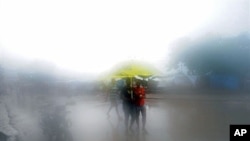Hurricane Tomas was bringing heavy rains to Haiti early Friday, raising concerns about possible flash floods and mudslides. Thousands of Haitians who were displaced by a January earthquake may be exposed to the storm.
U.S. forecasters say Tomas was upgraded from a tropical storm to a hurricane overnight as it moved northeast on a path between Cuba and Haiti.
Experts at the National Hurricane Center in Miami said the center of the hurricane should remain offshore, limiting the potential for wind damage.
But meteorologist Chris Landsea says experts are watching to see how the storm develops in coming hours. "The winds are not extremely destructive, and we are likely experiencing hurricane-force winds on the southwestern peninsula of Haiti right now where the hurricane is closest. Conditions look like they may intensify in the next day," said Landsea.
Watch Elizabeth Lee's Companion TV Report
Landsea says the hurricane is not likely to cause significant storm surge on coastal areas in Haiti. He said heavy rainfall, however, could affect inland and mountainous parts of Haiti, which may see as much as 40 centimeters of rain.
"That's a big concern because Haiti often gets flash floods or mudslides that occur when you get heavy rains with hurricanes. And with what has happened recently in Haiti that is even more of a concern than usual," Landsea said.
Clip: Hurricane Tomas Lashes Haiti with Wind
Haiti's government and relief groups have been working to relocate thousands of people who have been living in tent communities since the January earthquake. Thursday, scores of women and children were moved to a vacant hospital near the Corail camp, outside of Port-au-Prince.
Haiti's President Rene Preval and other top officials have been appealing to displaced residents to evacuate to strongly constructed buildings, if necessary, to avoid possible deaths. Hundreds of thousands of people remain homeless after the earthquake, which killed more than a quarter million people.
In Washington, U.S. officials said they have sent supplies to Haiti and have more equipment available to respond to the disaster. State Department spokesman P.J. Crowley said a big focus is monitoring public health and hygiene conditions after the storm, to avoid the possible spread of diseases.
Haiti has been struggling with a cholera epidemic, linked to contaminated water supplies in the Artibonite region, north of Port-au-Prince. The World Health Organization says more than 440 people have died in the outbreak.











